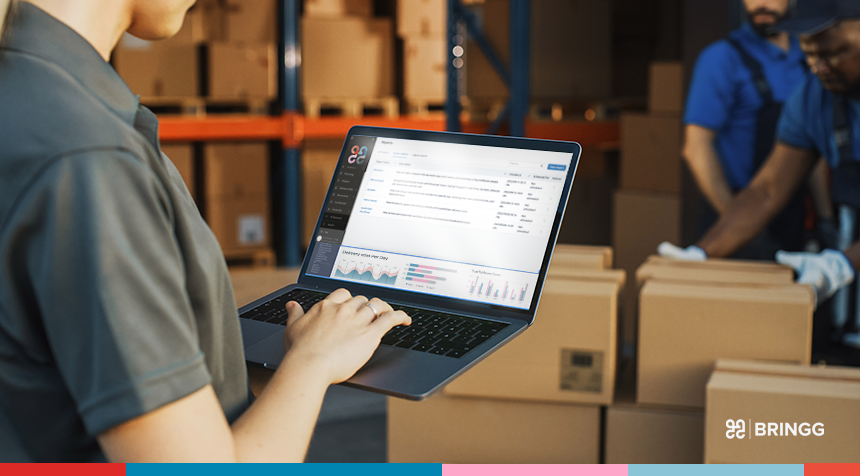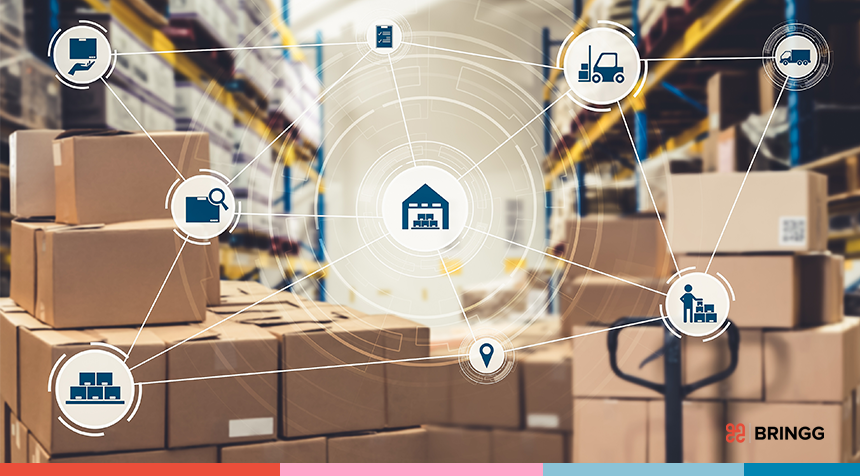Of all the delivery models in existence, just in time delivery (also known as JIT delivery) is perhaps the best known. While for years just in time manufacturing was associated with the Toyota production system pioneered by the Toyota motor corporation, the model constitutes a significant and widely-used process for effective supply chain management.
Just in time delivery requires moving inventory for delivery orders purely on an “as needed basis,” with the aim and chief benefit of significantly lowering inventory carrying costs by keeping inventory flowing from the moment it is picked. The just in time system is currently experiencing a new lease of life as just in time delivery is being realized as a reliable and useful solution to keep the fulfillment supply chain in motion from the end of the production process through the last mile in order to meet customer demand.
What is just in time delivery?
Just in time delivery means the process of creating goods in a ready state, or completing their production, so that a minimal inventory can satisfy demand and a delivery can take place with immediate effect in order that consumers receive what they want precisely when they want.
Restaurants are the perfect example of just in time delivery. A just in time system for delivery will, therefore, shift inventory only at the time that an order is made, and not before (this can prevent the issues and costs surrounding excess inventory).
The entire restaurant space relies on just in time delivery. When an order comes into the restaurant location, that order is prepared, cooked and packaged for collection to coincide with the pickup and delivery process. Otherwise that pizza is going to be cold, that burger is going to be soggy, or the condiments may be forgotten in the rush to hand over the order for delivery.
Just in time services are about getting the job done without missing anything, and by keeping everything moving seamlessly so that a minimal inventory satisfies demands. In the restaurant space, just in time delivery is critical for the freshness of the food. This is now being adopted and applied to every other category of products, including electronics, clothing, specialty retail and more.
For example, grocery delivery is another key adopter of just in time services. It’s crucial for groceries to be picked from shelves and be in a ready state when the delivery vehicle arrives for pick up, but it’s also important that refrigerated and frozen items are not allowed to warm up. Furthermore, there’s often a very short time window for grocery orders to be delivered. As such, these orders need to be carried out in the space of an hour or two.
Such tight windows mean that there’s no opportunity for inventory not to be ready, or for the hand-off process to be anything other than smooth. The SLA, the established contractual delivery time frame, for delivery will by definition be short.
Due to the importance of speed, the term “just in time delivery” has come to serve as a kind of catch-all that has permeated across different verticals within the retail delivery space. At its core. the concept centers on picking inventory efficiently, thereby reducing inventory holding costs in the supply chain, and then handing orders off to the fulfillment channel efficiently. All this, while providing visibility to the store associate and the customer along the way. Much like with just in time manufacturing, doing so helps decrease waste in both inventory costs as well as time wastage.
How does just in time delivery affect supply chain management?
Supply chain management is critical for any just in time system, and just in time delivery is no different. In all forms of delivery, keeping the supply chain moving without holdups is crucial, but with just in time delivery, it’s arguably even more pivotal.
That’s because with just in time delivery the products need both to be kept moving and also to arrive at precise times. This way, no unexpected waiting occurs, and neither will there be any need for additional storage costs.
Finding the balance in the supply chain is vital in keeping just in time delivery work properly. Supply chain management means inventory costs, storage costs and raw materials have to be managed in order to avoid holdups as well as excess inventory.
How just in time inventory management reduces costs
Done right, just in time delivery reduces costs across the entire supply chain by utilizing the origin point of inventory in an intelligent way. When a customer looks to check out on a website, and considers their available delivery options, two things are relevant for the retailer: First, what is the closest origin point of inventory, in order to provide the goods to the customer in a quick time frame, and second, what is the available capacity in the delivery network so that an order can be delivered as promised to the customer.
The origin point of inventory, once selected, can be a dark store, a regular retail location, a warehouse or somewhere else near the end of the supply chain. After being placed, orders are directed to a given location. Where the process becomes just in time is the stage at which the fulfillment vehicle arrives in order to collect and bring the order to the customer. It’s important that the picking of that inventory is executed in sync with the collection process.
As any retailer will know, one of the constraints with the retail store locations doing delivery is that there’s limited floor space available to hold orders that have been placed. Taking items off shelves and preparing them for delivery requires keeping them organized, and that in turn requires space, so it’s critical for just in time inventory management to keep the supply chain moving once they are picked. This is crucial, as it helps reduce costs by upping efficiency.
As such, the store associate picking inventory needs to receive the order request right before the delivery vehicle arrives. That timing, that synchronization, is precisely what just in time delivery is all about.
The process of forwarding an order request to a store associate, and the associate then picking the relevant inventory from a shelf, and then keeping the supply chain moving by transferring the goods to a delivery meal should take on average approximately five to ten minutes.
Just in time inventory management methods may differ depending on type of location. For example, in a dark store the supply chain hand-off may not be done by humans, but involve robotics performing both the picking and the handing over of goods to the delivery vehicle. In a warehouse location, by way of comparison, a section of the location may be dedicated to same-day delivery orders where the staging and other processes can be automated as much as possible.
Finally, an essential part of any just in time system is the ongoing communication between all the different moving parts of the process. Whether it’s a production process, a manufacturing process, or an inventory system, a constant stream of feedback enables continuous improvement. In the case of inventory management, regular communication helps in lowering costs by making sure that materials and orders keep moving in a constant flow without requiring much, if any, storage space on the way.
Problems with just in time delivery
One of the biggest problems is lack of visibility – and not just in the supply chain itself. For example, retailers readying orders for delivery need to know where delivery drivers on the way to pick up orders are located. But too often, it’s not at all clear.
A common challenge retail locations have is that store associates are busy trying to help customers in the store, take payments, handle returns and more. They don’t have an intelligent way to track the whereabouts of a third-party driver coming to the store, meaning they are essentially left in the dark until one party actively contacts the other.
This is a real bottleneck, as it means that the just-in-time element of the supply chain can be held up. It’s very common for a UPS or Fedex employee to enter a store to collect a drop shipment, but the store has no idea when that employee is arriving.
Why has just in time delivery become so popular?
The overall adoption of ecommerce has led to many changes in the delivery space, and with the pandemic having had a well-documented accelerating effect on that adoption, people want their orders faster, with convenient delivery and speed of delivery being crucial to customer decision-making.
In order to meet this growing demand, retailers need to have processes and systems in place to get orders out speedily and delivered when, where, and how customers want. Without such systems and a flexible supply chain, the processes will become clucky and inefficient. As such, just in time services are a great way to manage resources and retail space to meet that demand.
What are the benefits of just in time delivery?
Offering just in time delivery gives customers a very in-demand fulfillment channel in an efficient way. Done correctly, retailers can manage existing resources and existing inventory, and still fulfill on that same day, or immediately, to meet customer demand. If done less than optimally, it will be very difficult to meet that SLA and offer this service to the customer in a profitable way.
Once an order is picked, it’s essential to hand off the order to the driver in an efficient way. Any warehouse management solution, and any order management solution, must work well with the delivery platform in order to be time and cost efficient.
Just in time delivery helps reduce costs by providing intelligent ways for the retailer to either optimize their internal fleet or to outsource and dispatch to an external fleet. By offering both modes of internal and third-party fleet delivery, and having intelligent ways to hand the order over to meet that SLA, retailers can offer just in time services in a way that reduces costs and increases efficiency.
The difference can be drastic. If the retailer has the availability to offer within a two-hour timeframe, then this option can safely be offered at check-out and without harming profitability.
However, if a blanket promise is made to all customers that they can enjoy short, fast delivery windows, then the retailer ends up having to scramble internally in order to carry out the delivery. This can result in paying a premium to a delivery provider in order to collect the package and deliver it on time.



